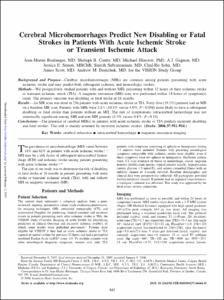Cerebral Microhemorrhages Predict New Disabling or Fatal Strokes in Patients With Acute Ischemic Stroke or Transient Ischemic Attack
- Keimyung Author(s)
- Sohn, Chul Ho
- Department
- Dept. of Radiology (영상의학)
- Journal Title
- Stroke
- Issued Date
- 2006
- Volume
- 37
- Issue
- 3
- Abstract
- Background and Purpose: Cerebral microhemorrhages (MHs) are common among patients presenting with acute ischemic stroke and may predict both subsequent ischemic and hemorrhagic strokes.
Methods: We prospectively studied patients with and without MHs presenting within 12 hours of their ischemic stroke or transient ischemic attack (TIA). A magnetic resonance (MR) scan was performed within 24 hours of symptom(s) onset. The primary outcome was disabling or fatal stroke at 18 months.
Results: An MR scan was done in 236 patients with acute ischemic stroke or TIA. Forty-five (19.1%) patients had an MH on a baseline MR scan. Patients with MHs were 2.8× (10.8% versus 4.0%; P=0.036) more likely to have a subsequent disabling or fatal stroke than patients without an MH. The risk of symptomatic intracerebral hemorrhage was not statistically significant among MH and non-MH patients (3.3% versus 0.8%; P=0.31).
Conclusions: The presence of cerebral MH(s) in patients with acute ischemic stroke or TIA predicts recurrent disabling and fatal strokes. This risk is mainly assumed by recurrent ischemic strokes.
- Keimyung Author(s)(Kor)
- 손철호
- Publisher
- School of Medicine
- Citation
- Jean-Martin Boulanger et al. (2006). Cerebral Microhemorrhages Predict New Disabling or Fatal Strokes in Patients With Acute Ischemic Stroke or Transient Ischemic Attack. Stroke, 37(3), 911–914. doi: 10.1161/01.STR.0000204237.66466.5f
- Type
- Article
- ISSN
- 0039-2499
- Appears in Collections:
- 1. School of Medicine (의과대학) > Dept. of Radiology (영상의학)
- 파일 목록
-
-
Download
 oak-aaa-4377.pdf
기타 데이터 / 333.65 kB / Adobe PDF
oak-aaa-4377.pdf
기타 데이터 / 333.65 kB / Adobe PDF
-
Items in Repository are protected by copyright, with all rights reserved, unless otherwise indicated.